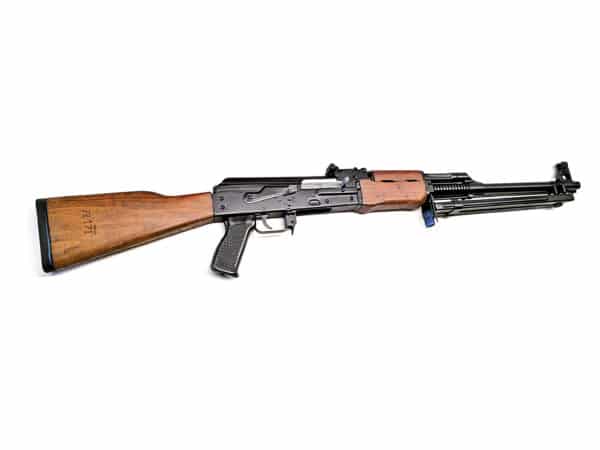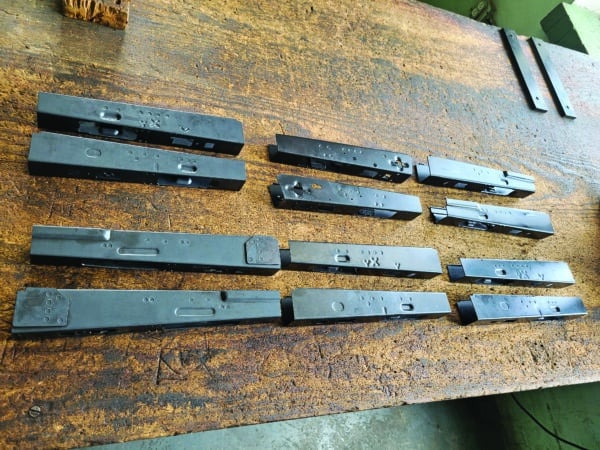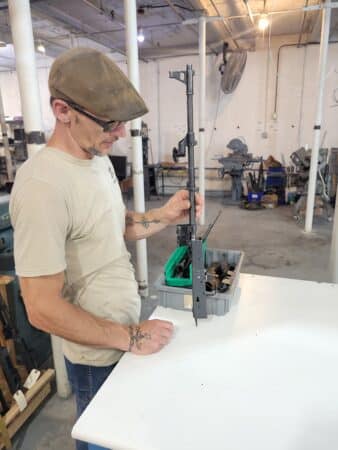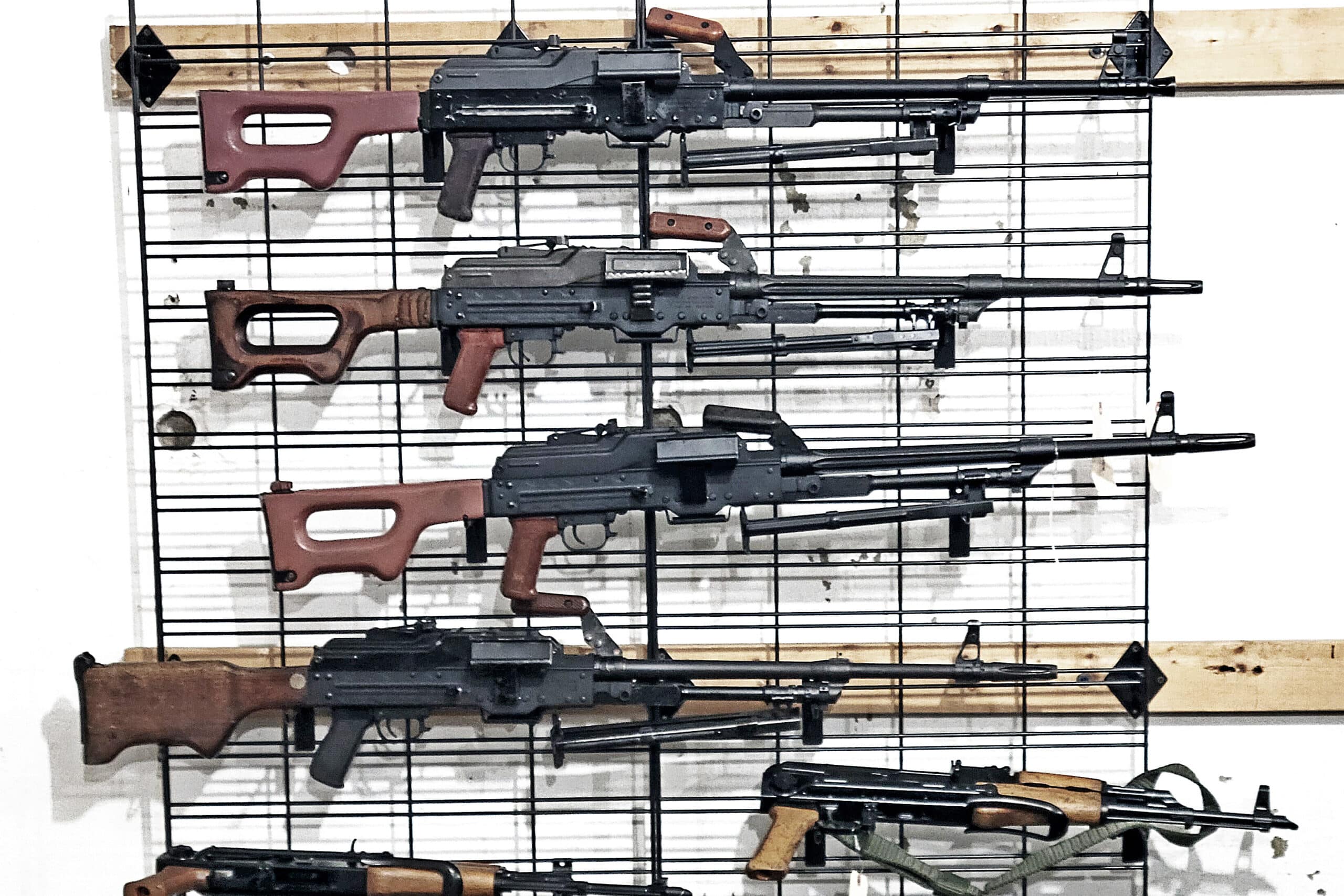You enter a small city situated in the interior of a mountainous region. Crossing a bridge, you begin to examine the architecture of a town that grew due to the quiet presence of organized crime. The city was something of a hideout, a sanctuary, where the locals benefited from the bosses, products, and people who flowed through. As you open your vehicle door, the heat assaults you with its presence. The sun feels like it’s 5 feet away at times.
The smell of industry permeates the air as you enter the building, blending the flash and whir of 21st century technology with the sound of metal being pressed, punched, and formed. That oddly comforting and reassuring smell of grease, CLP, and metal permeates your nostrils.
You are here to examine AKs built in a workshop full of artists, machinists, and engineers who have mastered the art of building the Soviet Union’s greatest export. You are not in Darra. Welcome to Appalachistan. You are in Fairmont, West Virginia, the home of Childers Guns, and you have just entered AK nirvana.

Many of us who remember the salad days of AKs rolling in from all points of the compass became hooked on the design then. It wasn’t just the inexpensive nature of the gun or the cheap ammo. These things were legend. For many of us, our fathers spoke of facing them in battle in Vietnam. Adjectives, such as indestructible and reliable, peppered the discussions. The AK had an aura about it. We saw it in Red Dawn. We saw it in Platoon and Full Metal Jacket and Hamburger Hill.
Many of us saved and scrimped at our part-time jobs to accumulate enough to buy one of the Chinese imports at $300. That was if we could make it past snatching up another new-in-box SKS with accessories at $50 or the seemingly endless piles of M1 Carbines at $150 from Blue Sky, or the racks upon racks of Enfields, Mosins, and Mausers pouring in at $50 to $100. We dreamt of the Gucci AKs from Valmet, and IMI.

Yet there were always some that were elusive. We saw pictures of exotic AKs we knew we would never have, like the real deal from the USSR, or the East German AKs that somehow managed to take the workers’ and peasants’ rifle and turn it into a finely tuned, beautifully finished teutonic death machine.
Childers Guns brings those days back. What’s more, they make our unobtanium obtainable. Ensconced in a quirky industrial building full of passages and vaults, Childers’ facility is quite simply amazing in its technological expanse. In one room, long sought, refurbished, and carefully maintained machinery from the 1950s gives the AK receivers made here the appropriate look of the period, in the next room, CAD programs are running, fleshing out the next project or design.

Cameron Childers’ fascination with the AK series began, like many of us, with the influences of youth introducing him to Mikhail’s Child. Unlike most of the rest of us, however, he had an innate desire to build AKs from the ground up. That is a pretty big leap. The AK is not a plug-and-play gun; it takes time, experience, and patience to learn to build the right way.
Not dissuaded by the complexities of the project, Cameron built his first AK in 2012 with a receiver he made in his garage. He still has that AK and is happy to display it to show how far the process has come in the decade-plus of experience since.

With the increased availability of parts kits over the past years, those unobtainable rifles became more accessible. Due to import regulations, which have been a moving target for a while, there are always parts that must be replaced in any AK-style firearm build.
The fire control group and receiver are the obvious bits, and eventually barrels had to be replaced too, as new regulations demanded it too be cut. While it seems some of these regulations may wane, receivers will always be torched. That created the key problem that Childers Guns stepped in to solve. Why build a specific AK (sometimes a highly desirable rarity) around a generic receiver with the wrong fit, finish, markings, and interior and exterior details?

The solution was considerable research and careful design. Childers now produces a line of AK receivers that cover most needs. The receivers not only conform to the appropriate exterior markings, but the other details are also built into the receiver to federal specifications so your Polish, Russian, or East German AK looks exactly like the original from the exterior.
The process combines state-of-the-art manufacturing with period tooling. The receivers are precision made, then period tools are used to make the exterior details look as close to the original as possible. When placed side by side, the Childers receivers on a minty parts set are almost indistinguishable from the original.
The details are first rate, but the staff are what makes the magic happen. It’s the human hands in the shop that make the machines work and provide the level of detail in the receivers.
The staff know their jobs extremely well, and what’s more, they are responsive. They answer emails with customers’ queries, and you don’t wait days for a response or worse hear crickets. They are also happy to help answer technical questions.

One of the hidden secrets of Childers Guns is their builds. While they have gained some notoriety for their receivers, they quietly build some of the best crafted AKs in the United States. Their staff can turn a parts kit into the AK you always wanted with confidence and experience. No matter how rare or unusual your kit, they have the tools and experience to complete the build. What’s more, the experience and expertise of the staff is a level or two deeper than most, but, again, rather humbly so.
If the multitude of AKs and variants were not enough to spend hours drooling over parts, bits, markings, and magazines, the whiplash from suddenly seeing fully functional PKMs and RPGs is something your chiropractor will appreciate. The staff regularly instruct foreign weapons familiarization programs for various military, law enforcement, and government organizations. This is not a garage operation with talent.

The staff and capabilities extend to the extremes of small arms design, manufacturing, function, and operation. The facility holds an endless variety of surprises for the enthusiast, and the gears start turning wondering what they might make next.
If you have ever wanted to build your own AK but have been curious as to how to do it, stay tuned. In the coming months, the staff at Childers will walk RECOIL’s readers through the process of assembling an AK from butt to tip, ground up, from a parts kit.
Read the full article here




